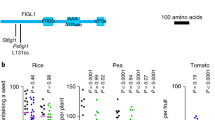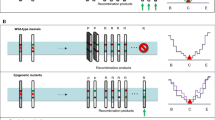Abstract
Sears (1956) pioneered plant chromosome engineering 50 years ago by directed transfer of a leaf rust resistance gene from an alien chromosome to a wheat chromosome using X-ray irradiation and an elegant cytogenetic scheme. Since then many other protocols have been reported, but the one dealing with induced homoeologous pairing and recombination is the most powerful, and has been extensively used in wheat. Here, we briefly review the current status of homoeologous recombination-based chromosome engineering research in plants with a focus on wheat, and demonstrate that integrated use of cytogenetic stocks and molecular resources can enhance the efficiency and precision of homoeologus-based chromosome engineering. We report the results of an experiment on homoeologous recombination-based transfer of virus resistance from an alien chromosome to a wheat chromosome, its characterization, and the prospects for further engineering by a second round of recombination. A proposal is presented for genome-wide, homoeologous recombination-based engineering for efficient mining of gene pools of wild relatives for crop improvement.
Similar content being viewed by others
References
Aghaee-Sarbarzeh M, Singh H, Dhaliwal HS (2000) Ph I gene derived from Aegilops speltoides induces homoeologous chromosome pairing in wide crosses of Triticum aestivum. J Hered 91: 418–421.
Aghaee-Sarbarzeh M, Ferrahi M, Singh S et al. (2002) Ph I-induced transfer of leaf and stripe rust-resistance genes from Aegilops triuncialis and Ae. geniculata to bread wheat. Euphytica 127: 377–382.
Chen PD, Tsujimoto H, Gill BS (1994) Transfer of Ph I genes promoting homoeologous pairing from Triticum speltoides to common wheat. Theor Appl Genet 88: 97–101.
Davies PA, Pallotta MA, Driscoll CJ (1985) Centric fusion between nonhomologous rye chromosomes in wheat. Can J Genet Cytol 27: 627–632.
Dubcovsky J, Luo M, Dvorak J (1995) Differentiation between homoeologous chromosomes 1A of wheat and 1Am of Triticum monococcum and its recognition by the wheat Ph1 locus. Proc Natl Acad Sci USA 92: 6645–6649.
Dunford RP, Kurata N, Laurie DA, Money TA, Minobe Y, Moore G (1995) Conservation of fine-scale DNA marker order in the genome of rice and the Triticeae. Nucleic Acids Res 23: 2724–2728.
Endo TR, Gill BS (1996) The deletion stocks of common wheat. J Hered 87: 295–307.
Friebe B, Mukai Y, Dhaliwal HS, Martin TJ, Gill BS (1991) Identification of alien chromatin specifying resistance to wheat streak mosaic and greenbug in wheat germ plasm by C-banding and in situ hybridization. Theor Appl Genet 81: 381–389.
Friebe B, Jiang J, Raupp WJ, McIntosh RA, Gill BS (1996) Characterization of wheat–alien translocations conferring resistance to diseases and pests: current status. Euphytica 91: 59–87.
Friebe B, Zhang P, Linc G, Gill BS (2005) Robertsonian translocations in wheat arise by centric misdivision of univalents at anaphase I and rejoining of broken centromeres during interkinesis of meiosis II. Cytogenet Genome Res 109: 293–297.
Gill BS, Chen PD (1987) Role of cytoplasm-specific introgression in the evolution of the polyploid wheats. Proc Natl Acad Sci USA 84: 6800–6804.
Gill BS, Raupp WJ (1987) Direct genetic transfers from Aegilops squarrosa L. to hexaploid wheat. Crop Sci 27: 445–450.
Gill BS, Friebe B, Endo TR (1991) Standard karyotype and nomenclature system for description of chromosome bands and structural aberrations in wheat (Triticum aestivum). Genome 34: 830–839.
Gill BS, Friebe B, Wilson DL, Martin TJ, Cox TS (1995) Registration of KS93WGRC27 wheat streak mosaic virus-resistant T4DL-4Ai#2S wheat germplasm. Crop Sci 35: 1236–1237.
Giorgi B (1983) Origin, behavior and utilization of a Ph1 mutant of durum wheat, Triticum turgidum (L.) var. durum. In Sasakuma S, ed., Proceedings, Sixth International Wheat Genetics Symposium, Kyoto, Japan, pp. 1033–1040.
Griffiths S, Sharp R, Foote TN et al. (2006) Molecular characterization of Ph1 as a major chromosome pairing locus in polyploidy wheat. Nature 439: 749–752.
Huang L, Brooks SA, Li W et al. (2003) Map-based cloning of leaf rust resistance gene Lr21 from the large and polyploid genome of bread wheat. Genetics 164: 655–664.
Huang SX, Sirikhachornkit A, Su XJ et al. (2002) Genes encoding plastid acetyl-CoA carboxylase and 3-phosphoglycerate kinase of the Triticum/Aegilops complex and the evolutionary history of polyploid wheat. Proc Natl Acad Sci USA 99: 8133–8138.
Islam AKMR, Shepherd KW (1992) Production of wheat-barley recombinant chromosomes through induced homoeologous pairing. Theor Appl Genet 83: 489–494.
Jenczewski E, Eber F, Grimaud A et al. (2003) PrBn, a major gene controlling homeologous pairing in oilseed rape (Brassica napus) haploids. Genetics 164: 645–653.
Ji Y, Chetelat RT (2003) Homoeologous pairing and recombination in Solanum lycopersicoides monosomic addition and substitution lines of tomato. Theor Appl Genet 106: 979–989.
Jiang J, Friebe B, Gill BS (1994) Recent advances in alien gene transfer in wheat. Euphytica 73: 199–212.
Kamstra SA, Kuipers AGJ, De Jeu MJ, Ramanna MS, Jacobsen E (1999) The extent and position of homoeologous recombination in a distant hybrid of Alstroemeria: a molecular cytogenetic assessment of first generation backcross progenies. Chromosoma 108: 52–63.
Khan IA (1999) Detection of wheat–alien recombinant chromosomes using co-dominant DNA markers. Ann Appl Biol 135: 579–583.
Khrustaleva LI, de Melo PE, van Heusden AW, Kik C (2005) The integration of recombination and physical maps in a large-genome monocot using haploid genome analysis in a trihybrid Allium population. Genetics 169: 1673–1685.
King J, Armstead IP, Donnison IS et al. (2002) Physical and genetic mapping in the grasses Lolium perenne and Festica pratensis. Genetics 161: 315–324.
Liang GH, Wang RC, Niblett CL, Heyne EG (1979) Registration of B-6-37-1 wheat germ plasm. Crop Sci 19: 421.
Lukaszewski AJ (1993) Reconstruction in wheat of complete chromosomes 1B and 1R from the 1RS.1BL translocation of ‘Kavkas’ origin. Genome 36: 821–824.
Lukaszewski AJ (1994) Manipulation of the genome by chromosome breakage, In Gill BS, Raupp WJ, eds., Proceedings, US–Japan Symposium, Classical and Molecular Cytogenetic Analysis, March 1994, Manhattan, Kansas, USA, pp. 136–139, 21–23.
Lukaszewski AJ (1995) Physical distribution of translocation breakpoints in homoeologous recombinants induced by the absence of the Ph1 gene in wheat and triticale. Theor Appl Genet 90: 714–719.
Lukaszewski AJ (1997) Further manipulation by centric misdivision of the 1RS.1BL translocation in wheat. Euphytica 94: 257–261.
Lukaszewski AJ (2000) Manipulation of the 1RS·1BL translocation in wheat by induced homoeologous recombination. Crop Sci 40: 216–225.
Lukaszewski AJ, Xu X (1995) Screening large populations of wheat hybrids by C-banding. Cereal Res Comm 23: 9–13.
Lukaszewski AJ, Rybka K, Korzun V, Malyshev SV, Lapinski B, Whitkus R (2004) Genetic and physical mapping of homoeologous recombination points involving wheat chromosome 2B and rye chromosome 2R. Genome 47: 36–45.
Lukaszewski AJ, Lapinski B, Rybka K (2005) Limitations of in situ hybridization with total genomic DNA in routine screening for alien introgressions in wheat. Cytogenet Genome Res 109: 373–377.
Martin TJ (1978) Procedures for evaluating wheat streak mosaic virus resistance. Plant Dis Rep 62: 239–284.
Masoudi-Nejad A, Nasuda S, McIntosh RA, Endo TR (2002) Transfer of rye chromosome segments to wheat by a gametocidal gene. Chromosome Res 10: 349–357.
McFadden ES, Sears ER (1946) The origin of Triticum spelta and its free-threshing hexaploid relatives. J Hered 37: 81–89.
Mullan DJ, Platteter A, Teakle NL et al. (2005) EST-derived SSR markers from defined regions of the wheat genome to identify Lophopyrum elongatum specific loci. Genome 48: 811–822.
Naranjo T, Roca A, Goicoechea PG, Giraldez R (1987) Arm homoeology of wheat and rye chromosomes. Genome 29: 873–882.
Nasuda S, Friebe B, Busch W, Kynast RG, Gill BS (1998) Structural rearrangement in chromosome 2M of Aegilops comosa has prevented the utilization of the Compair and related wheat–Ae. comosa translocations in wheat improvement. Theor Appl Genet 96: 780–785.
Okamoto M (1957) Asynaptic effect of chromosome V. Wheat Inf Serv 5: 6.
O’Mara JG (1940) Cytogenetic studies on Triticale. I. A method for determining the effects of individual Secale chromosomes on Triticum. Genetics 25: 401–408.
Peng JH, Lapitan NLV (2005) Characterization of EST-derived microsatellites in the wheat genome and development of eSSR markers. Funct Integr Genomics 5: 80–96.
Qi LL, Echalier B, Friebe B, Gill BS (2003) Molecular characterization of a set of wheat deletion stocks for using in chromosome bin mapping of ESTs. Funct Integr Genomics 3: 39–55.
Qi LL, Echalier B, Chao S et al. (2004) A chromosome bin map of 16,000 expressed sequence tag loci and distribution of genes among the three genomes of polyploidy wheat. Genetics 168: 701–712.
Riley R, Chapman V (1958) Genetic control of cytologically diploid behavior of hexaploid wheat. Nature 182: 713–715.
Riley R, Chapman V, Johnson R (1968a) The incorporation of alien disease resistance in wheat by genetic interference with the regulation of meiotic chromosome synapsis. Genet Res Camb 12: 198–219.
Riley R, Chapman V, Johnson R (1968b) Introduction of yellow rust resistance of Aegilops comosa into wheat by genetically induced homoeologous recombination. Nature 217: 383–384.
Roberts MA, Reader SM, Dalgliesh C et al. (1999) Induction and characterization of Ph1 wheat mutants. Genetics 153: 1909–1918.
Robertson WMRB (1916) Chromosome studies. I. Taxonomic relationships shown in the chromosomes of Tettegidae and Acrididiae: V-shaped chromosomes and their significance in Acrididae, Locustidae and Grillidae: chromosomes and variations. J Morphol 27: 179–331.
Rogowsky PM, Sorrels ME, Shepherd KW, Langridge P (1993) Characterisation of wheat–rye recombinants with RFLP and PCR probes. Theor Appl Genet 83: 489–494.
Rozen S, Skaletsky HJ (2000) Primer3 on the WWW for general users and for biologist programmers. In Krawetz S, Misener S, eds., Methods and Protocols: Methods in Molecular Biology. Totowa, NJ: Bioinformatics Humana Press, pp. 365–386.
Sallee PJ, Kimber G (1978) An analysis of the pairing of wheat telocentric chromosomes. In Ramanujam S, ed., Proceedings, 5th International Wheat Genetics Symposium. New Delhi, India: Indian Society of Genetics and Plant Breeding, pp. 408–419.
Sears ER (1952) Misdivision of univalents in common wheat. Chromosoma 4: 535–550.
Sears ER (1954) The aneuploids of common wheat. Univ Mo Agric Exp Stn Bull 572: 1–58.
Sears ER (1956) The transfer of leaf rust resistance from Aegilops umbellulata to wheat. Brookhaven Symp Biol 9: 1–22.
Sears ER (1966) Nullisomic-tetrasomic combinations in hexaploid wheat. In Riley R, Lewis KR, eds., Chromosome Manipulations and Plant Genetics. Edinburgh: Oliver and Boyd, pp. 29–45.
Sears ER (1972) Chromosome engineering in wheat. In Redei G, ed., Fourth Stadler Symposia, University of Missouri, Columbia, pp. 23–38.
Sears ER (1973) Agropyron-wheat transfers induced by homoeologous pairing. In Sears ER, Sears LMS, eds., Proceedings, Fourth International Wheat Genetics Symposium, Columbia, MO, Agriculture Experiment Station, College of Agriculture, University of Missouri, Columbia, MO, pp. 191–199.
Sears ER (1977) An induced mutant with homoeologous pairing in common wheat. Can J Genet Cytol 19: 585–593.
Sears ER (1981) Transfer of alien genetic material to wheat. In Evans LT, Peacock WJ, eds., Wheat Science – Today and Tomorrow. Cambridge: Cambridge University Press, pp. 75–89.
Sears ER, Okamoto M (1958) Intergenomic chromosome relationships in hexaploid wheat. Proceedings, 10th International Congress of Genetics, Montreal, 2: 258–259.
Segal G, Liu B, Vega JM, Abbo S, Rodova M, Feldman M (1997) Identification of a chromosome-specific probe that maps within the Ph1 deletion in common and durum. Theor Appl Genet 94: 968–970.
Wells DG, Kota RS, Sandhu HS, Gardner WAS, Finney KF (1982) Registration of one disomic substitution line and five translocation lines of winter wheat germ plasm resistant to wheat streak mosaic virus. Crop Sci 22: 1277–1278.
Yu JK, La Rota M, Kantety RV, Sorrells ME (2004) EST derived SSR markers for comparative mapping in wheat and rice. Mol Gen Genomics 271: 742–751.
Zhang P, Li W, Friebe B, Gill BS (2004) Simultaneous painting of three genomes in hexaploid wheat by BAC-FISH. Genome 47: 979–987.
Zwierzykowski Z, Lukaszewski AJ, Naganowska B, Lesniewska A (1999) The pattern of homoeologous recombination in triploid hybrids of Lolium multiflorum with Festica pratensis. Genome 42: 720–726.
Author information
Authors and Affiliations
Corresponding author
Additional information
Contribution number 07-65-J of the Kansas Agricultural Experiment Station, Kansas State University, Manhattan, KS 66506–5502, USA.
Rights and permissions
About this article
Cite this article
Qi, L., Friebe, B., Zhang, P. et al. Homoeologous recombination, chromosome engineering and crop improvement. Chromosome Res 15, 3–19 (2007). https://doi.org/10.1007/s10577-006-1108-8
Published:
Issue Date:
DOI: https://doi.org/10.1007/s10577-006-1108-8




